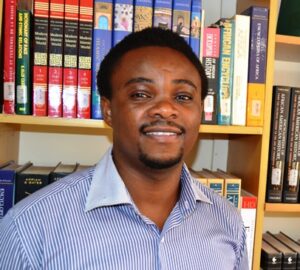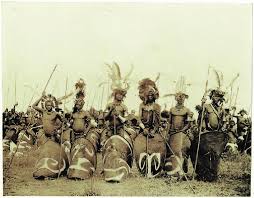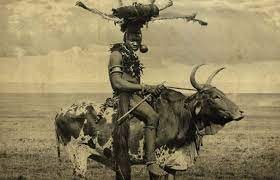 During my vacation, I decided to do something different. I chose to dig into my history and culture in order to get deeper understanding of things and convert theories into facts of stories that were not clear. When I was doing thorough research with proper interviews and consultations, I listened keenly and came to realize that when a story is carefully told, it could evoke emotions with a deep understanding of the community’s traditions and values. Every Person you meet is a library of stories, with a bundle of experiences. Teaching the younger generations traditional values helps to create a more cohesive society where good morals are upheld.
During my vacation, I decided to do something different. I chose to dig into my history and culture in order to get deeper understanding of things and convert theories into facts of stories that were not clear. When I was doing thorough research with proper interviews and consultations, I listened keenly and came to realize that when a story is carefully told, it could evoke emotions with a deep understanding of the community’s traditions and values. Every Person you meet is a library of stories, with a bundle of experiences. Teaching the younger generations traditional values helps to create a more cohesive society where good morals are upheld.
The Luo indigenous culture has aesthetics and cosmologies that are very complex and sometimes even difficult to comprehend, but this linguistic tool if properly utilized can be used for team building, conflict management, and community development. It can also spearhead cultural diversity which brings a collective strength that can benefit all of humanity. Tales of legends, the naming ceremonies, witchcraft, and medicine men surround the community and everyone has their own twisted version of the stories they tell.
Jobilo as pronounced by Luos (witchcraft and medicine men) are believed to have supernatural powers. The power to hypnotize, sermon supreme beings, and sometimes even harm others. The legendary and mysterious Gor Kogalo was immensely feared. It was believed that the guy could transform people and even cause their disappearance. Some claimed that Kogalo could take people from their sleep to go help plough his farms unknowingly and unconscious and they could often realise later when they wake up tired, muddy, and with no idea of what conspired while they were sleeping. His house was surrounded by old artifacts and mystical symbols. It was also believed that he could turn himself into an old woman as he pleased whenever he found himself in trouble with people whom he believed were going to do him harm.
Just like the Greek mythology of the legend of Hercules, and the Bible story of Samson. Luos also had the Legend of Luanda Magere, a warrior like no other, renowned for his bravery and strength. He possessed supernatural powers, and his flesh was made of stone. He deflected arrows and spears, making him invincible during the war. He was a one-man army who was famously known for his capability to tear an entire army apart. Luanda was born in the year 1720 to Abonyo McOmolo and his mother, was called Nyabera Nyar Alego, who was acquainted well with traditional medicine and healing. After his mother’s death during his birth, his grandmother raised him. His father died in one of the numerous wars with their Nandi neighbours when Luanda was just a mere teenager. Luanda Magere belonged to the Sidho clan in Kano (Jo Kano), on the shores of Lake Victoria who currently occupies the present-day sugar belt at the foot of the Nandi escarpment. As we speak, there is a site in Sidho with a stone which is still revered as the spot where Luanda Magere died and turned into a rock. From time-to-time people come from different regions to visit, and conduct rituals and prayers at the site. The site is about a few kilometers from the Awasi-Chemelil road, heading to Kopere – Sing’hor junction. Pregnant women are not allowed to the site for fear of miscarriage.
According to the Luo traditional stories, enemies at the time were called jo Lang’o, the Luo name for the Kalenjin community. The kalenjins had well-trained and mass numbers of highly adrenalized youth but they could not stand a chance with Luanda’s strength, nobody knew how he could get a physical injury, not even among the Luos.
The Lang’o, tired of being defeated in war by the Luo, sat down with Nandi elders to discuss the issue. They spoke of the challenges and persecution they endured in the hands of Luanda Magere during the war and how best they could come up with solutions, and as the saying goes, to every strength there is always a weakness. So, they concluded that they would give Luanda Magere a woman to marry, claiming it was a gesture of peace. The woman’s real role was to find out how to defeat him. We are well acquainted with the story of Samson and how his love for Delilah led to his betrayal and death, well this story is similar but with a different outcome. Even Though the Luo elders advised him not to marry her, Luanda Magere could not heed their advice, and neither could he resist the charms of the lady standing before him, it was as if he was hypnotized, her appearance portrayed the beauty of a goddess it was as if her parents were divine.
After many attempts, his gifted wife was successful one day, when he fell ill and requested her care. Luanda instructed her to cut his shadow with a knife and administer the medicine. She was surprised when she saw his shadow bleed. That night when she got a chance, she crept out of Luanda’s simba (crib house), ran back to her people, and told them her husband’s weakness.
With no delay, they then decided to attack the Luos that Night. The Luos fought fiercely and Luanda managed to kill so many Nandi warriors that they decided to retreat. As they were running, one Nandi warrior remembered that Luanda’s strength was in his shadow. He stood at a hill and threw his spear at Luanda’s shadow. Luanda Magere fell down and died, and his body turned to stone.
I wanted to conclude my story there, but then I remembered the conspicuous Gaudencia Aoko, a Luo legend who co-founded Legio Maria at the age of 20, the largest independent church in Africa that seceded from the Roman Catholic church and also has its own Pope. Perhaps one of the most misunderstood sects in the south-western Kenya, with beliefs that its founder Melchio Ondeto was the real son of God or black Jesus as others would like to call him. To the followers of Jo Legio, there is no Saint that is highly venerated like Mother Mary and they always have an annual assembly in remembrance of Saint Mary.
Legio Maria was believed to have started in the years between the 1950s-1960s when Ondeto, his mother, and co-founder and sister-in-law Gaudencia Aoko were thrown out of the main catholic church for engaging in exorcism and other practices that were not in line with the doctrines of the Roman Catholic church. Naturally, they were banned almost immediately, and the Catholic Church hated them. Also naturally, they attracted a lot of intellectuals and artists. More than 200,000 Catholics seceded and followed Ondeto. Some of the events however, of course, were told with a different twist in order to make it more dramatic and appealing to the ears of the leaders of the church but the way they conduct their services with hymns, reciting of the rosary and the traditional Latin mass, is clearly evident that they have a connection with the Catholic church.
The faithful kneel and recite a prayer in the form of a song whenever they meet other faithful on the roadsides or wherever, they remove their shoes at the entrance of the compound and at some point, people can have their future handed to them in a piece of paper. Furthermore, the stronger members of the sect, have six of their lower teeth removed as a sign of initiation and also there are certain foods that they don’t eat, like Kamongo (marbled lungfish), and Cowpeas leaves, vegetables which they believe that Adam and Eve used to cover themselves with while they were in the garden of Eden.
There are other Luo legends who founded other churches, but they did not live long to see them materialize, like Alfayo Odongo Mang’o who rebelled from the church missionary society, the current Anglican Church to found his own Roho church (Roho fueny) in the 1920s. His followers came from all over protestants and Catholics from Luo-land and neighbouring Luhyas, Kisiis’ and the Kuria. The fact still remains that both Catholic and other Western churches in Kenya are still growing rapidly. Due to rapid development of schism, a holy war emerged between his followers and that of his competitors from Abakholwe of Musanda, Abamarachi, and Abasamia from Busia which led to his lynching in the church and later claimed that the church was attacked by raiders. The Abakholwe, Abamarachi, and Abasamia are usually bi-lingual, they speak both Luo and Luhya fluently, and now, they have dispersed in western parts of Kenya and Nyanza region but most of them now reside in the Busia border and Mumias respectively.
There are other many founders of many African churches that am afraid to mention in this platform for fear of contradiction, who broke away from the Catholic church and formed their own churches between 1906-1907. They embraced circumcision and spearheaded immoral activities that put them in conflict with the Luo traditional elders, and for that reason, they were murdered.
When I went to the lake side of the Nyanza region to learn if there was any history that was related to the lake, I learned that blessings can sometimes be burdensome and tiring, especially those blessings that we did not ask for. Sometimes we wonder whether they are blessings or curses, some are things that we must fight against, yet most of us choose to embrace them and do it with love and willingness of the heart depending with the benefits that we derive from them.
I think in this day and age where facts and truth are in short supply, I owe it to my readers to give them a factual representation of events as they appeared in December 1906 in Luo Nyanza. A strong wave like no other was witnessed on the shores of Lake Victoria with a worm air like a breath that seemed to have come from a cave or a nostril of a living Creature, with storm and thunder echoing in the distance, later an apparition of a giant serpent slithered out of Lake Victoria and revealed itself to one Luo chief whose name was name was referred to as MUMBO (which means chosen) by the serpent. The atmosphere became heavier and darker. It turned out that the chief’s ancestors had practiced dark rituals back in the days to obtain wealth and power, and the consequences of those acts haunted them and led to their deaths.
In the process of their ritual activities, they ended up summoning an ancient and powerful force, unaware of the terrible consequences. For those who pledged their loyalty to the snake and chose to worship it, their crops grew in plenty and there was no longer a need to work. Furthermore, they were rewarded with cattle that were believed to have come from the lake. These activities were alarming and the rumours of a miracle snake that gifted people riches spread further to the neighbouring regions. It attracted followers which led to the formation of Mumboism a cult like no other.
The then colonial government did an investigation and reported that there were new converts and indeed they received multiple sheep, goats, and cows. The rumours had it that the purpose of the emergence of the serpent was to help locals get rid of colonialism and when this news reached the government they wasted no time to act accordingly having witnessed what the snake could do, there was panic among the Europeans. For fear of disastrous outcomes, the colonial government then conducted an operation, where people were abducted. The leaders of the cult were then detained in different towns of the country, like Mombasa, Kisii, and Kisumu and they were led to believe that they were ferried to Europe to explain where they got the powers to sermon serpents.
We’ve all heard of Omieri, a giant serpent that emerged in Nyakach Luo Nyanza. It is believed that the Serpent anointed a certain bloodline and after a certain cycle in time, its descendants just like Omieri usually appear to homes with that bloodline. The paradox of all these apparitions is that nobody knows when they will come and when they will disappear. The creature is believed to exist between two worlds. The old Luo medicine men knew how to sermon the serpent, but it is believed that some betrayed others and revealed those secrets to the Europeans and broke the covenant between them and the serpent’s descendants. Occasionally, and randomly it appears at its convenience to different people who are deemed worthy and it doesn’t stay long before it disappears.
It causes abnormal rains, and strong winds, and also cows, sheep, and goats are believed to be giving birth two in two and pregnant women are usually not allowed to see it for belief that they will give birth to infants that has strips on their bodies, and these strips are believed to be strangling them as they grow. Marcus Garvey Said “a people without the knowledge of their past history, origin and culture is like a tree without roots.”
Philip Opiyo,
Librarian, JHIA





